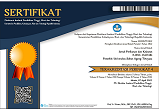Prospek Penerapan Traceability Perikanan Udang Di Pelabuhan Perikanan Samudera Cilacap (Implementation Prospects For Traceability of Shrimp Fisheries In Cilacap Oceanic Fishing Port)
Abstract
Cilacap is one of the shrimp exporter areas in Indonesia. The exported shrimp from this area is mostly dominated by aquaculture and capture fisheries. The prospect of shrimp catch traceability has not been applied because it is still complicated in term of information about the fishing ground of shrimp and shrimp catch data from supplier and lack of governance. Shrimp fisheries in Cilacap are dominated by small-scale fisheries that usually have not been certified and may be affected by international commerce. Based on that explanation, it is important to conduct a study about shrimp traceability readiness in Cilacap. A purposive sampling and accidental sampling method were used in this research, accompanied by descriptive content analysis. The result shows that the readiness of Cilacap shrimp fisheries is still in the stage of concept preparation. The standard value of handling and processing shrimp according to Indonesian National Standard. Facilities that support the traceability system function properly. Enumeration intervention may be used to support a proper small-scale fisheries traceability in Cilacap.
Keywords
Full Text:
PDFReferences
Asensio L, Gonzalez I, Gracia T, Martin R. 2008. Determination of food authenticity by enzyme-linked immunosorbent assay (ELISA). Food Control. 19(2008): 1-8.
Astawan M. 2008. Penanganan dan Pengolahan Hasil Perikanan. Tangerang Selatan (ID): Universitas Terbuka. 21hlm.
Bailey M, Bush SR, Miller A, Kochen M. 2016. The role of traceability in transforming seafood governance in the global South. Current Opinion in Environmental Sustainability. 18:25-32.
Baroqi R. 2016. Spot tracer as a verification tool for fishing ground data. MDPI. : http://mdpi.or.id/spot-tracer-as-a-verification-tool-for-fishing-ground-data/
[diakses 2018 Nov 27].
Bush SR, Bailey M, Zwieten P, Kochen M, Wiryawan B, Doddema A, Mangunsong SC. 2017. Private provision of public information in tuna fisheries. Marine Policy. 77(2017): 130-135.
Doddema M, Spaargaren G, Wiryawan B, Simon RB. 2018. Fisher responses to private monitoring interventions in an Indonesian tuna handline fishery. Fisheries Research. 208(2018):49-57.
Halim, A, Wiryawan B, Lorenagan NR, Hordyk A, Sondita M, White AT, Koeshendrajana S, Ruchimat T, Pomeroy RS, Yuni C. 2018. Developing a funcitonal definition of small-scale fisheries in support of marine capture fisheries management in Indonesia. Marine Policy (in prep). 4(2):239-262
Hizbulloh L. 2017. Internal traceability system for small and medium sized tuna processor: tally-o. MDPI. http://mdpi.or.id/internal-traceability-system-for-small-and-medium-sized-tuna-processor-tally-o/. [diakses 2018 Nov 27].
Hosch G, Blaha F. 2017. Seafood traceability for fisheries compliance: country-level support for catch documentation schemes. Rome: FAO Fisheries and Aquaculture Technical Paper. 84p.
Ihsan MK. 2017. Kebutuhan kompetensi nelayan kapal rawai tuna yang berbasis di Pelabuhan Perikanan Samudera Cilacap Jawa Tengah [skripsi]. Bogor (ID): Institut Pertanian Bogor. 5hlm.
[KKP] Kementerian Kelautan dan Perikanan. 2016. SHTI jadi ‘pagar’ hasil laut Indonesia. http://www.djpt.kkp.go.id/read/shti-jadi-pagar-hasil-laut-indonesia . [diakses 2018 Jul 24].
[KKP] Kementerian Kelautan dan Perikanan. 2017. Produktivitas perikanan Indonesia. https://kkp.go.id/wp-content/uploads/2018/01/KKP-Dirjen-PDSPKP-FMB-Kominfo-19-Januari-2018.pdf. [diakses 2018 Okt 3].
Lewis SG, Boyle M. 2017. The expanding role of traceability in seafood: tools and key initiatives. Jurnal of food science. 82: 13-21.
Madduppa H, Zairion, Nurani S, Nugroho K, Nugraha BA. 2016. Setting up traceability tools for the Indonesian blue swimming crab fishery: A case study in Southeast Sulawesi. Fisheries and Aquaculture in the Modern World. 7:143-157.
[MDPI] Yayasan Masyarakat dan Perikanan Indonesia. 2015. Laporan Tahunan MDPI 2015.http://mdpi.or.id/images/pdf_list/annualreport/MDPI_Annual_Report_2015_INDONESIAN_ONLINE.pdf. [diakses 2018 Nov 12].
Pramono YE, Fathoni M, Marpaung H, Wiropurnomo H, Hanifah T, Robiyanto S, Aida N. 2015. Pedoman Ekspor Perikanan ke Negara Mitra (Belanda, Thailand dan Jepang). Jakarta (ID): KKP. 140hlm.
Prianto T. 2018. Perikanan tuna handline skala kecil dan persepsi nelayan terhadap penerapan program fair trade di Parigi, Maluku Tengah [SKRIPSI]. Bogor (ID): Institut Pertanian Bogor. 21 hlm.
Starr LE. 2016. Blowing it out of the water: How breaking down illegal, unreported, and unregulated (IUU) fishing can contribute to its effective management in Indonesia using an area based approach. http://dalspace.library.dal.ca/bitstream/handle/10222/72682/Starr_L_MMMGraduateProject.pdf?sequence=1&isAllowed=y. [diakses 2018 Agt 14].
Sudibyo A. 2012. Sistem ketelusuran pada industri pangan dan produk hasil pertanian. Jurnal of Agro-Based Industry. 29(2): 43-62.
Zulfikar R. 2016. Cara penanganan yang baik pengolahan produk hasil perikanan berupa udang. Jurnal Aplikasi Teknologi Pangan. 5(2): 29-30.
DOI: http://dx.doi.org/10.33512/jpk.v11i1.9438
Refbacks
- There are currently no refbacks.



_-_Copy1.png)